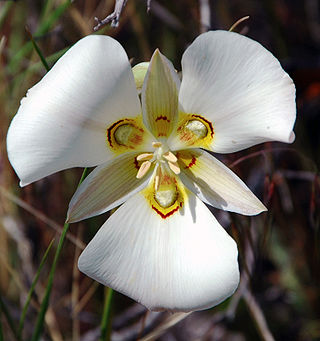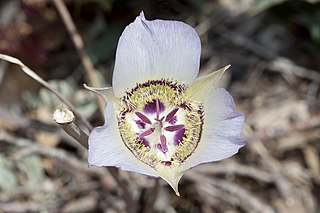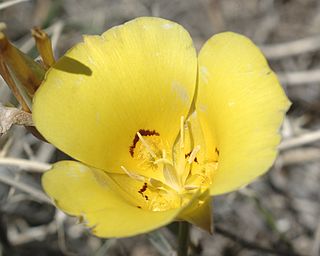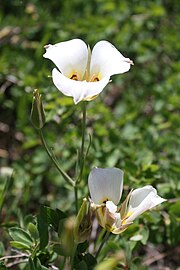The Shoshone or Shoshoni are a Native American tribe with four large cultural/linguistic divisions:

Calochortus is a genus of flowering plants in the lily family. The group includes herbaceous, perennial and bulbous species, all native to North America.
The Utah Native Plant Society (UNPS) is a non-profit organization dedicated to the appreciation, preservation, conservation and responsible use of the native plants and plant communities found in the state of Utah and the Intermountain West. Its goal is to foster public recognition of the spectacularly diverse flora of the state.

Calochortus luteus, the yellow mariposa lily, is a mariposa lily endemic to California.

Salix lasiolepis is a species of willow native to western North America.
The sego lily is a bulbous perennial endemic to the Western U.S., and is the state flower of Utah.

Calochortus macrocarpus, also known as sagebrush mariposa lily, is a North American species of bulbous perennials in the lily family.

Calochortus elegans is a species of flowering plant in the lily family known by the common name elegant Mariposa lily, cat's ear, elegant cat's ears or star tulip. It is native to the western United States from northern California to Montana.

Calochortus leichtlinii is a species of flowering plant in the lily family known by the common names Leichtlin's mariposa, smokey mariposa, and mariposa lily.

Calochortus panamintensis is a rare North American species of flowering plants in the lily family known by the common name Panamint mariposa lily. It is native to Inyo and Kern Counties in California, plus adjacent Nye County, Nevada. It is named after the Panamint Range near Death Valley.

Calochortus persistens is a rare North American species of flowering plant in the lily family known by the common name Siskiyou mariposa lily. It is native to northern California and southern Oregon.

Calochortus weedii is a North American species of flowering plants in the lily family known by the common name Weed's mariposa lily.

Allium tolmiei is a plant species native to Idaho, eastern and central Oregon, southeastern Washington, northwestern Nevada and northeastern California. It occurs on mountains and scrublands at elevations of 1,300–9,200 feet (400–2,800 m). It was discovered by and named for Dr. William Fraser Tolmie.

Calochortus ambiguus, the Arizona mariposa lily or doubting mariposa lily, is a perennial plant in the lily family (liliaceae) that grows at higher elevations of the Sonoran Desert regions of Arizona, western New Mexico, southern Utah, and Sonora.
Calochortus venustulus is a Mexican species of plants in the lily family native to central and eastern Mexico and bearing yellow flowers. Two varieties are recognized.

Calochortus aureus is a North American species of flowering plants in the lily family. It is native to the southwestern United States. Calochortus aureus is a bulb-forming perennial herb producing a single stalk up to 30 cm tall. Flowers are bright lemon-yellow with red or purple splotches on the petals.
Calochortus ciscoensis is a North American species of flowering plants in the lily family first described for modern science in 2008. It was originally described as only occurring only in eastern Utah but has since also been found in Mesa County, Colorado).

Calochortus gunnisonii commonly known as Rocky Mountain mariposa or Gunnison mariposa lily is a North American species of flowering plant in the lily family. It is native to the western United States, primarily in the Rocky Mountains and Black Hills: Arizona, New Mexico, Utah, Colorado, Wyoming, Montana, South Dakota, Washington state (Grant County, northwestern Nebraska and eastern Idaho.

Calochortus longibarbatus is a species of flowering plant in the lily family with the common names long-haired star-tulip and longbeard mariposa lily. It is native to Oregon, Washington, and northern California, where it grows in the forest and woodlands of the mountains.

















